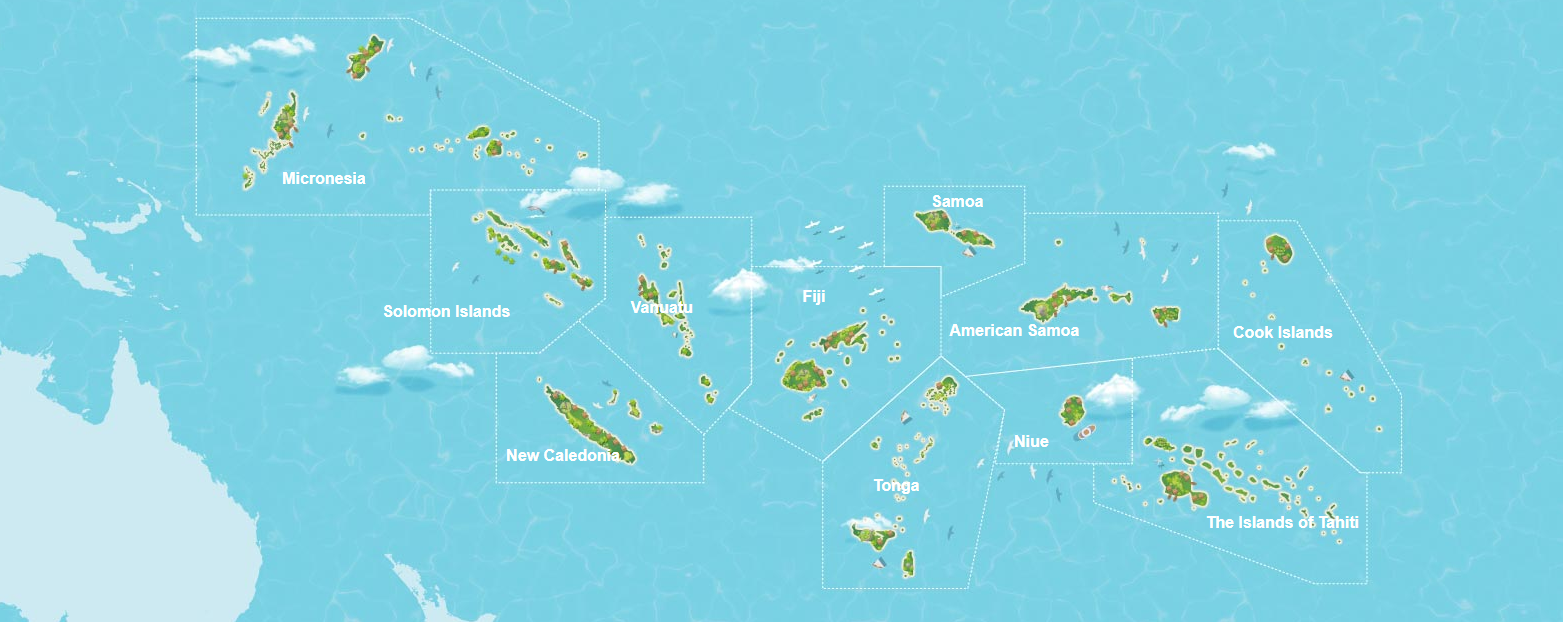There is no other region in the world apart from the South Pacific that has such cultural, geographic, climatic, historical and indigenous allure. The vibrant mixes of Polynesian, Melanesian and Micronesian ethnicities uniquely culminate across the disparate regions of Fiji, New Caledonia, Samoa, Vanuatu, Tonga, Cook Islands, Islands of Tahiti, Niue, Micronesia and additionally Papua New Guinea. Each region holds unique values, traditions, ancestral fables and conceptualisations of of paradise and tropical splendour. Dating back from the discovery times vivid imagery and superlatives encapsulate the South Pacific spirit. Metaphors such as the following reverberate the sentimentalities of perfection and paradise and continue to aspire awe in modern day travellers whom come from lands far and many to embrace this region of the world:
After an hour of high clouds and blue ocean the green islands shimmered into view. They were in the middle of nowhere: it was another experience of the Pacific being like the night sky, like outer space, and of island hopping in that ocean being something like interplanetary travel.
Paul Thoreaux’s description of his arrival in the Trobriands (1992, p. 132):
The recruitment of tourism as a device for promotion and monetization of the South Pacific is central in creating a multiplier effect that trickles through to economic development factors. These collectively inspire increased employment, urban development, cultural amplification, improved education, increased sustainable development, foreign direct investment, easing balance of payment constraints, transfer of technology and knowledge and sets the bar higher for all pacific island countries. Whilst there has been contention amidst academic and research institutions on the actual benefits accrued by the increase in tourism in these nations due to the prevalence and degree of economic leakages (and hence lower multiplier effect) between the tourism-oriented sectors and other sectors of the economy; it is important to note that the very notion of transformational tourism can be seen as a powerful ideological category or trope that will enhance the regions competitive advantage in the world. The figures speak for themselves here as “in terms of overall numbers, South Pacific Tourism Organisation (SPTO) reports that 2.30 million tourists arrived in PICs in 2016 (SPTO, 2017a 2017 2017, 2017b). Arrivals have been increasing at an average rate of around 4.9% over the last decade (1.34 million tourism arrivals in 2007).
So what is transformational tourism and how can the countries in the South Pacific adopt this stance to foster breakthrough growth on inbound tourism? Accordingly, transformational tourism alludes to the mechanics by which private/public institutions, governments, tourism sellers, tourism buyers, airlines and origin countries come together to execute a destination marketing plan that focuses on leveraging the key strategic advantages of the regions they wish to promote. It focuses on accentuating unique cultural and geographic elements that can be used intelligently to promote and nurture growth and educate origin countries and travellers in the purpose and greater meaning behind travelling to the South Pacific region. Its important to ensconce paradigms here that contribute to a type of appreciative inquiry into the destination and why certain customs, flora and fauna exist and their greater part and role through history and into the current age. For example, in the Fiji Islands, its important to understand that land is leased by the traditional iTauki owners to hotel chains over long durations, creating income that would not exist before, but at the same time, appreciating that traditional activities may be hampered (farming, fishing, grazing) but which need to be conductively explored by the local governments to continue its preservation. This means that whilst tourism and urban development brings inflows into the economy, the government adopts a strategic stance and cultivates ongoing agribusiness opportunities to maintain the customary traditions. They then support this through information technology mandates to create a virtual supply chain which leverages farming from all regions of the mainland and islands and then participate in export activities; further enhancing the regions competitive advantage not only through inbound tourism but the growth in exports and the preservation of traditions which are crucial to maintain Fiji’s subsistence and create a shield against seasonal dips in tourism which otherwise would hurt the economy momentarily. Fiji will also, here, be combatting import inflation wherein local goods start accounting higher for household consumption therefore putting less pressure on the costs of living. Creating these kind of interplays will also result in more jobs, higher wage growth, increased standard of living and act as an economic tool by easing the stress on the balance of payments. Ultimately, by doing this in collaboration with international and local institutions, transformational tourism is taking place by supporting the full gamut of primary, secondary and tertiary markets in the economy.
This example of inter-sectoral collaboration and value chain evolution is by no means exhaustive as there are multiple ways in which a collaborative approach can be adopted by all entities in the ecosystem. The key driver here will be to take an open stance and view towards fostering the right kind of incentives, structures, ideas and executing them in a systematic and focused way to achieve mutually beneficial outcomes. The South Pacific region is primed for huge growth due to a number of initiatives that have set themselves as enablers and frameworks to promote sustainable development and urban growth. Therefore, it will be absolutely critical for all entities to commit to transformational tourism as an economic tool to amplify the regions competitive advantage in the world. Yes, there will be threats and impediments ahead, however, it is managing these and working collectively that will drive the results. I allude to a scholarly article below which outline six key themes that will need to be understood and considered before we go any further.
Webster and Ivanov’s (2015) six geopolitical drivers that impact world tourism are applicable to the South Pacific and Pacific Island Countries.
1. The fall of the American Empire
2. The rise of the BRICs (Brazil, Russia, India, China) and PINEs (Philippines, Indonesia, Nigeria, and Ethiopia)
3. Increased global political instability
4. The increased importance of regional supranational organizations
5. Greater control of individuals on a global level
6. Corporations become more important and powerful than governments
Webster and Ivanov’s (2015)


